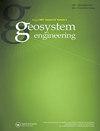Modeling hydraulic fracture fluid efficiency in tight gas reservoirs using non-linear regression and a back-propagation neural network
IF 1.1
Q3 GEOSCIENCES, MULTIDISCIPLINARY
引用次数: 0
Abstract
ABSTRACT This study introduces a back-propagation (BP) neural network model and a regression model for estimating the fracture fluid efficiency based on a data set consisting of 1261 staged and ramped simulation runs of tight gas reservoirs subjected to hydraulic fracturing treatment. Data were generated using a 3-D commercial simulator which is a versatile software portfolio that models many well configurations, proppant placement, and fracture geometries. The BP network inputs consist of shear rate/fracture conductivity ratio, the injection rate, reservoir permeability, formation closure stress, reservoir thickness, effective viscosity, and fracture height. The neural network model was able to generate satisfactory estimates of the fracture fluid efficiency for the training dataset, and for the blind testing data. An average error of approximately 2.5% was obtained for the training set, and an average error of 3% was obtained for the testing set. An empirical non-linear regression model has been constructed based on dimensionless groups derived by applying dimensional analysis to a set of variables consisting of the maximum fracture width, fracture length, fracture height, effective viscosity, shear rate/fracture conductivity ratio, reservoir thickness, injection rate, reservoir permeability, and formation closure stress. The average error for estimating the fluid efficiency using the non-linear regression empirical model was approximately 6.17%. Since the non-linear regression model has an explicit formulation, it is easier to apply than the neural network model. The empirical regression model estimates of the fluid efficiency appeared to be unbiased and were more precise than those estimates obtained using either the KGD or the PKN 2-D models. The introduced BP model and the non-linear regression model offer fast and inexpensive alternatives to the application of three-dimensional simulators for estimating the fluid efficiency.基于非线性回归和反向传播神经网络的致密气藏水力压裂液效率建模
摘要基于1261次压裂模拟数据集,建立了BP神经网络模型和回归模型,用于估算压裂液效率。数据是使用3d商用模拟器生成的,该模拟器是一种多功能软件组合,可以模拟多种井的配置、支撑剂的放置和裂缝的几何形状。BP网络输入包括剪切速率/裂缝导流比、注入速率、储层渗透率、地层闭合应力、储层厚度、有效粘度和裂缝高度。该神经网络模型能够为训练数据集和盲测数据生成令人满意的压裂液效率估计。训练集的平均误差约为2.5%,测试集的平均误差为3%。通过对最大裂缝宽度、裂缝长度、裂缝高度、有效粘度、剪切速率/裂缝导流比、储层厚度、注入速率、储层渗透率、地层闭合应力等变量进行量纲分析,建立了无量纲群的经验非线性回归模型。利用非线性回归经验模型估算流体效率的平均误差约为6.17%。由于非线性回归模型有一个明确的公式,它比神经网络模型更容易应用。经验回归模型对流体效率的估计似乎是无偏的,并且比使用KGD或PKN二维模型获得的估计更精确。引入的BP模型和非线性回归模型为三维仿真器的流体效率估算提供了快速、廉价的替代方法。
本文章由计算机程序翻译,如有差异,请以英文原文为准。
求助全文
约1分钟内获得全文
求助全文

 求助内容:
求助内容: 应助结果提醒方式:
应助结果提醒方式:


